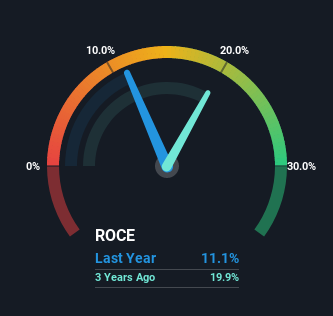- Hong Kong
- /
- Electronic Equipment and Components
- /
- SEHK:1723
There Are Reasons To Feel Uneasy About HK Asia Holdings' (HKG:1723) Returns On Capital
To find a multi-bagger stock, what are the underlying trends we should look for in a business? One common approach is to try and find a company with returns on capital employed (ROCE) that are increasing, in conjunction with a growing amount of capital employed. Ultimately, this demonstrates that it's a business that is reinvesting profits at increasing rates of return. Having said that, from a first glance at HK Asia Holdings (HKG:1723) we aren't jumping out of our chairs at how returns are trending, but let's have a deeper look.
What Is Return On Capital Employed (ROCE)?
For those that aren't sure what ROCE is, it measures the amount of pre-tax profits a company can generate from the capital employed in its business. The formula for this calculation on HK Asia Holdings is:
Return on Capital Employed = Earnings Before Interest and Tax (EBIT) ÷ (Total Assets - Current Liabilities)
0.11 = HK$19m ÷ (HK$184m - HK$9.7m) (Based on the trailing twelve months to September 2022).
Thus, HK Asia Holdings has an ROCE of 11%. On its own, that's a standard return, however it's much better than the 7.4% generated by the Electronic industry.
See our latest analysis for HK Asia Holdings

Historical performance is a great place to start when researching a stock so above you can see the gauge for HK Asia Holdings' ROCE against it's prior returns. If you want to delve into the historical earnings, revenue and cash flow of HK Asia Holdings, check out these free graphs here.
What Does the ROCE Trend For HK Asia Holdings Tell Us?
When we looked at the ROCE trend at HK Asia Holdings, we didn't gain much confidence. To be more specific, ROCE has fallen from 60% over the last five years. However, given capital employed and revenue have both increased it appears that the business is currently pursuing growth, at the consequence of short term returns. And if the increased capital generates additional returns, the business, and thus shareholders, will benefit in the long run.
On a related note, HK Asia Holdings has decreased its current liabilities to 5.3% of total assets. That could partly explain why the ROCE has dropped. What's more, this can reduce some aspects of risk to the business because now the company's suppliers or short-term creditors are funding less of its operations. Some would claim this reduces the business' efficiency at generating ROCE since it is now funding more of the operations with its own money.
The Bottom Line
Even though returns on capital have fallen in the short term, we find it promising that revenue and capital employed have both increased for HK Asia Holdings. But since the stock has dived 95% in the last three years, there could be other drivers that are influencing the business' outlook. Regardless, reinvestment can pay off in the long run, so we think astute investors may want to look further into this stock.
If you want to know some of the risks facing HK Asia Holdings we've found 2 warning signs (1 is significant!) that you should be aware of before investing here.
While HK Asia Holdings may not currently earn the highest returns, we've compiled a list of companies that currently earn more than 25% return on equity. Check out this free list here.
New: Manage All Your Stock Portfolios in One Place
We've created the ultimate portfolio companion for stock investors, and it's free.
• Connect an unlimited number of Portfolios and see your total in one currency
• Be alerted to new Warning Signs or Risks via email or mobile
• Track the Fair Value of your stocks
Have feedback on this article? Concerned about the content? Get in touch with us directly. Alternatively, email editorial-team (at) simplywallst.com.
This article by Simply Wall St is general in nature. We provide commentary based on historical data and analyst forecasts only using an unbiased methodology and our articles are not intended to be financial advice. It does not constitute a recommendation to buy or sell any stock, and does not take account of your objectives, or your financial situation. We aim to bring you long-term focused analysis driven by fundamental data. Note that our analysis may not factor in the latest price-sensitive company announcements or qualitative material. Simply Wall St has no position in any stocks mentioned.
About SEHK:1723
Moon
An investment holding company, engages in the wholesale and retail sale of the pre-paid products in Hong Kong.
Flawless balance sheet with low risk.
Market Insights
Community Narratives


Recently Updated Narratives


Engineered for Stability. Positioned for Growth.


MINISO's fair value is projected at 26.69 with an anticipated PE ratio shift of 20x


Fiverr International will transform the freelance industry with AI-powered growth
Popular Narratives


MicroVision will explode future revenue by 380.37% with a vision towards success


NVDA: Expanding AI Demand Will Drive Major Data Center Investments Through 2026



